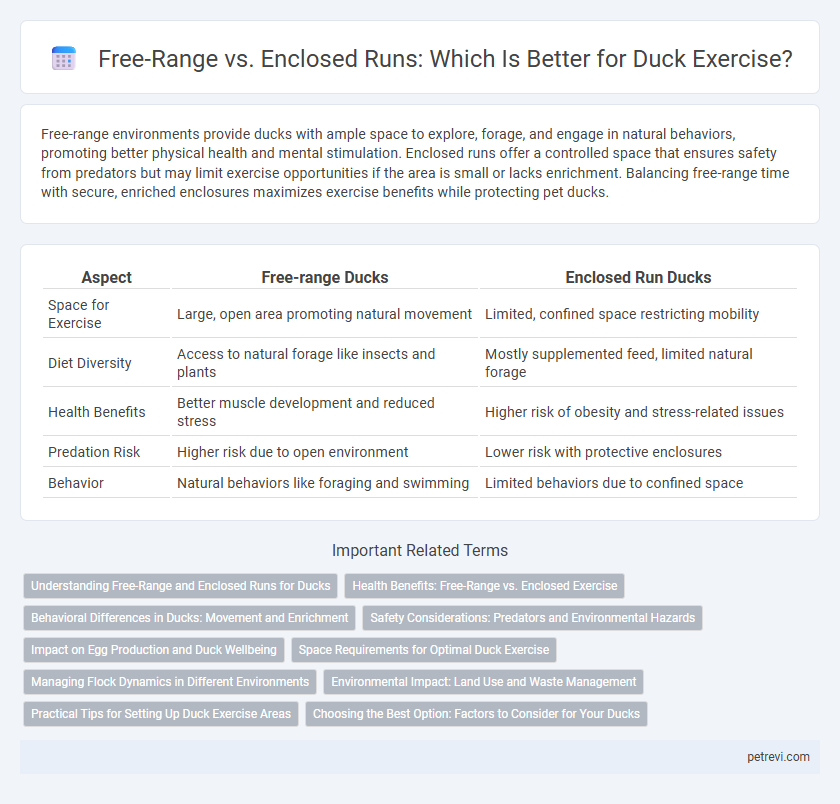Free-range environments provide ducks with ample space to explore, forage, and engage in natural behaviors, promoting better physical health and mental stimulation. Enclosed runs offer a controlled space that ensures safety from predators but may limit exercise opportunities if the area is small or lacks enrichment. Balancing free-range time with secure, enriched enclosures maximizes exercise benefits while protecting pet ducks.
Table of Comparison
| Aspect | Free-range Ducks | Enclosed Run Ducks |
|---|---|---|
| Space for Exercise | Large, open area promoting natural movement | Limited, confined space restricting mobility |
| Diet Diversity | Access to natural forage like insects and plants | Mostly supplemented feed, limited natural forage |
| Health Benefits | Better muscle development and reduced stress | Higher risk of obesity and stress-related issues |
| Predation Risk | Higher risk due to open environment | Lower risk with protective enclosures |
| Behavior | Natural behaviors like foraging and swimming | Limited behaviors due to confined space |
Understanding Free-Range and Enclosed Runs for Ducks
Free-range systems for ducks provide extensive space for natural behaviors like foraging, swimming, and social interactions, which enhance their overall well-being and physical fitness. Enclosed runs offer a controlled environment that protects ducks from predators and harsh weather while allowing limited exercise and access to outdoor elements. Balancing the benefits of free-range freedom with the security of enclosed runs is essential for optimizing duck health and productivity.
Health Benefits: Free-Range vs. Enclosed Exercise
Free-range exercise allows ducks to forage naturally, promoting better muscle development, improved cardiovascular health, and stronger immune systems due to increased physical activity and exposure to diverse environments. Enclosed runs limit movement, often resulting in less vigorous exercise and potentially higher stress levels, which can negatively impact overall duck health. Access to free-range areas reduces the risk of obesity and enhances feather condition, contributing to longer lifespan and improved reproductive success.
Behavioral Differences in Ducks: Movement and Enrichment
Free-range ducks exhibit a wider range of natural behaviors, including foraging, swimming, and social interactions, which promote better physical health and mental stimulation. Enclosed run environments limit movement and reduce opportunities for natural enrichment, often leading to increased stress and repetitive behaviors. Providing diverse habitats that mimic natural conditions enhances duck welfare by encouraging active exploration and varied exercise.
Safety Considerations: Predators and Environmental Hazards
Free-range ducks have increased exposure to predators such as foxes, raccoons, and birds of prey, making secure fencing and predator-proof shelters essential for safety. Enclosed runs offer better protection from environmental hazards like extreme weather, but require proper ventilation and space to prevent stress and illness. Both systems demand constant monitoring to minimize risks from predators and harmful surroundings while promoting healthy exercise.
Impact on Egg Production and Duck Wellbeing
Free-range environments enhance duck wellbeing by allowing natural behaviors such as foraging and swimming, which reduce stress and improve overall health, directly boosting egg production quality and quantity. Enclosed runs limit movement and natural behaviors, often leading to increased stress and lower egg yield due to restricted exercise and poorer mental stimulation. Research shows ducks with access to free-range conditions consistently produce larger, healthier eggs and exhibit stronger immune responses compared to those confined in enclosed runs.
Space Requirements for Optimal Duck Exercise
Optimal duck exercise requires ample space, with free-range setups offering significantly more room--typically over 100 square feet per duck--compared to enclosed runs, which often provide less than 50 square feet per bird. Adequate space encourages natural behaviors such as foraging, swimming, and social interaction, which are essential for ducks' physical health and mental well-being. Ensuring at least 10 square feet of outdoor water area supports exercise needs in both environments, but free-range allows for greater movement and diversity in activities.
Managing Flock Dynamics in Different Environments
Managing flock dynamics in free-range environments allows ducks to exhibit natural behaviors such as foraging and social interaction, promoting physical and psychological well-being. Enclosed runs provide a controlled setting that reduces predator risks and limits aggressive encounters but may restrict movement and natural exercise. Balancing space, shelter, and social structure is crucial for optimizing health and minimizing stress in both free-range and enclosed run systems.
Environmental Impact: Land Use and Waste Management
Free-range duck exercise systems utilize larger land areas, promoting natural foraging and reducing concentrated waste buildup, which mitigates soil and water contamination risks. Enclosed runs confine ducks to smaller spaces, intensifying waste accumulation and requiring efficient manure management to prevent environmental degradation. Sustainable land use in free-range setups supports biodiversity and soil health, while enclosed systems demand rigorous waste treatment to minimize pollution.
Practical Tips for Setting Up Duck Exercise Areas
Free-range setups allow ducks ample space to forage naturally, promoting healthier exercise and reducing stress, but require secure fencing to protect from predators. Enclosed runs offer controlled environments with easy access to water and shelter, ensuring safety while facilitating regular movement. Practical tips for creating duck exercise areas include providing diverse terrain, incorporating shallow pools for swimming, and maintaining clean, well-drained surfaces to prevent disease.
Choosing the Best Option: Factors to Consider for Your Ducks
Free-range environments allow ducks to exercise naturally by foraging and swimming in varied terrain, promoting better muscle development and mental stimulation. Enclosed runs provide controlled safety from predators and environmental hazards, but may limit movement and natural behaviors if space is restricted. Key factors to consider include available space, predator risk, climate, and the ducks' breed to ensure optimal health and well-being.
Free-range vs Enclosed run for Duck exercise Infographic

 petrevi.com
petrevi.com